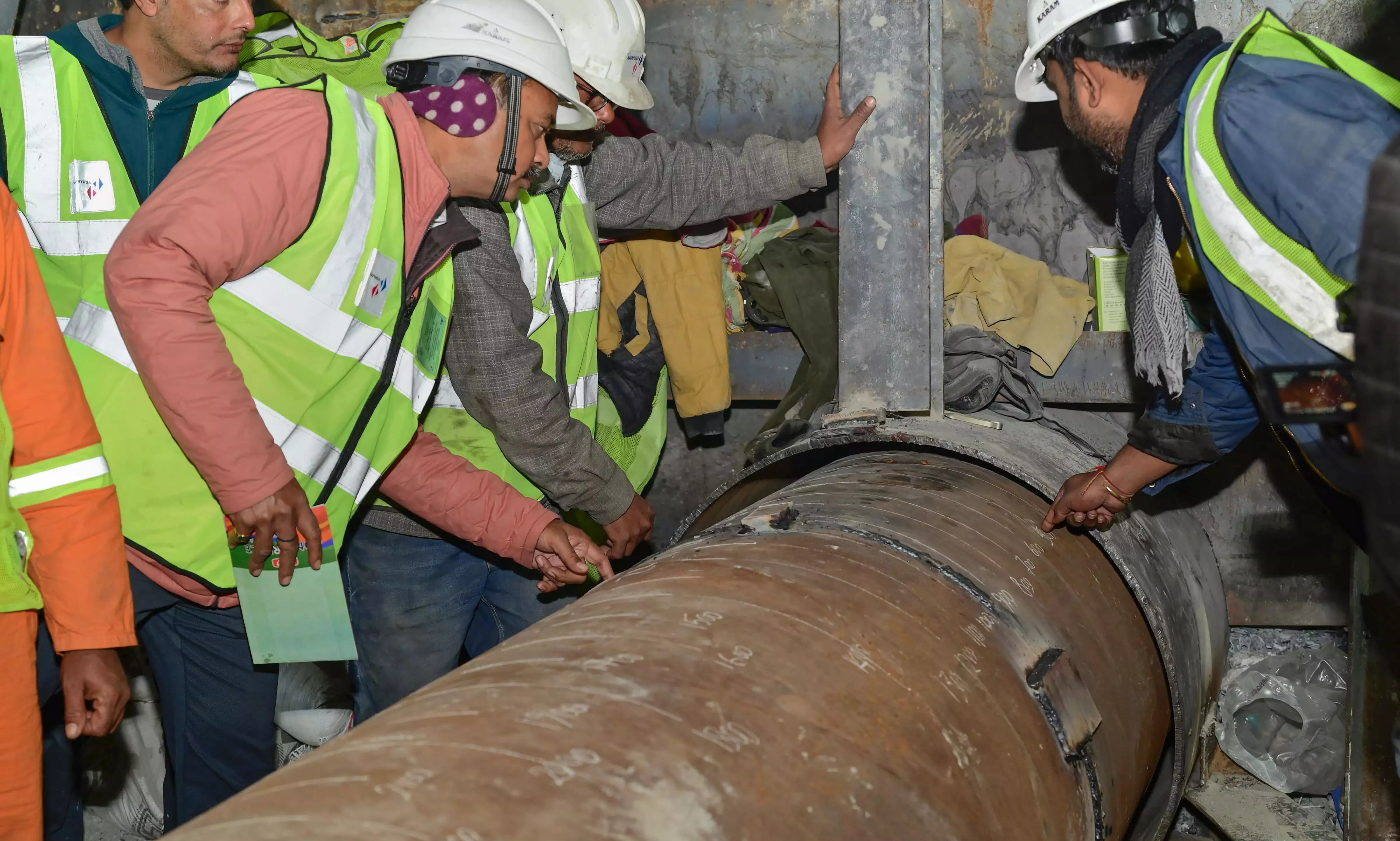
Silkyara tunnel collapse: Rescuers break through rubble, freedom in sight for 41 workers
A skilled team of workers removed the muck by hand using the rat-hole mining technique while 800-mm diameter pipes were pushed by an auger machine

When only 5 metres were left, preparations got underway to rush the trapped workers to a hospital for immediate medical care following their rescue. A separate ward comprising 41 oxygen-supported beds has been readied at the community health centre in Chinyalisaur, about 30 km from Silkyara.
The road outside the tunnel, which became uneven due to regular movement of heavy vehicles over the past fortnight was being repaired and a fresh layer of soil was being laid for smooth movement of ambulances.
Senior police officers briefed the security personnel outside the tunnel to spring into action the moment workers start coming out of the escape passage being prepared for them.
Rat-hole mining technique
Rescuers fell back on the rat-hole mining technique following the failure of heavy machinery to drill through the rubble to create an escape passage for them.
Twelve rat-hole mining experts will be involved in manual drilling and excavation horizontally through the final 10 or 12 metres of debris of the collapsed portion of the under-construction tunnel on the Char Dham route.
Simultaneously, vertical drilling from above the tunnel has reached a depth of 36 metres out of the 86 metres needed.
Rat-hole mining is a controversial and hazardous procedure in which miners in small groups go down narrow burrows to excavate small quantities of coal. It is often associated with Meghalaya, where holes are drilled for mining small amounts of coal.
Uttarakhand government’s nodal officer Neeraj Khairwal, however, made it clear that the men brought to the site were not “rat-hole miners” as such but people who are experts in the technique.
The experts have come from Delhi, Jhansi, and other parts of the country. They are likely to be divided into teams of two or three. Each team will go into the steel chute laid into the escape passage for brief periods.
“They will have to drill at least 10 to 12 metres with their own hands. They will mostly use two tools — hand-held drilling machines to remove the rubble and gas cutters for cutting the iron hurdles,” explained an official.
“As they remove the muck, the tunnel pipe (800-mm) will be pushed gradually by the machine through the rubble,” Khairwal said.
“We will do the drilling and collect the muck with our hand. We have been doing this for years,” one of the workers, Mohan Rai, told PTI. “We can remove five–six metres of rubble using this method in 24 hours,” Rai said.
He said they will be in proper gear, wearing oxygen masks and glasses to cover their eyes.
Rakesh Rajput, another expert, said three of them will go inside the tunnel, one will do the drilling, another will collect the muck and the third one will push the muck through the trolley.
Another expert in the rat-hole mining technique said they can remove 10 metres of muck or rubble in 20 hours.
Auger machine’s failure
This drilling was earlier being carried out by a huge auger machine that got stuck in the rubble on Friday, forcing officials to focus on an alternative option — drilling down from above the tunnel. About 40 per cent of the 86-metre vertical drilling required is now done.
For the horizontal through-the-rubble option, officials decided that the final stretch would be handled manually because obstacles like iron girders will have to be tackled. It’s because of those metal structures that the auger machine failed.
By Monday evening, the last bit of the stuck auger had been cut out piece by piece and a steel pipe inserted further into the partially complete escape passage.
Vertical drilling progresses
In Delhi, National Disaster Management Authority (NDMA) member Lt Gen (retd) Syed Ata Hasnain said vertical drilling, which began Sunday, has already reached a depth of 36 metres.
Rescuers hope to pull out workers through this one-metre-wide shaft when it breaks through the top of the tunnel below, hopefully by Thursday.
Another eight-inch-wide shaft being drilled from a nearby point has reached about 75 metres down.
This probe, which is also expected to act as a supply line for the trapped workers, has indicated that there were no serious geological obstacles for the main shaft up to this point, the NDMA member and officials at Silkyara said.
The vertical drilling, however, encountered some water underground, and “dewatering” was carried out, officials said. But it didn’t seriously affect the operation.
Workers’ situation
PK Mishra, Principal Secretary to the Prime Minister, Home Secretary Ajay Bhalla, and Uttarakhand Chief Secretary SS Sandhu went to Silkyara on Monday to take stock of the operation.
Mishra spoke to the trapped workers, assuring them that multiple agencies were at work to evacuate them and they should remain patient. Gabbar Singh Negi talked to the official through the communication link on behalf of other workers inside the tunnel.
They are in a 2-km built-up stretch of the tunnel and are being supplied food, medicines and other essentials through a six-inch pipeline. “They are in very good health,” Hasnain said.
He said it was difficult to give a timeline for the manual operation at this stage.
The NDMA member said a yellow alert has been issued by the meteorological department indicating light rains in the next 24 to 48 hours. “But there is no possibility that work will be hindered because of this,” he added.
He said Mishra has directed officials to ensure all medical facilities for the trapped workers as “difficulties could increase with the passage of time”.
(With agency inputs)

